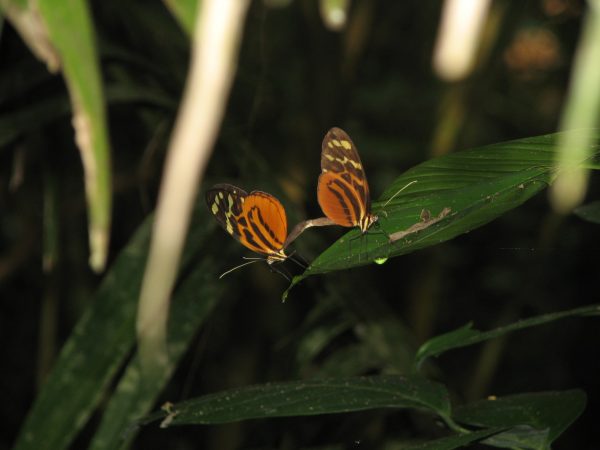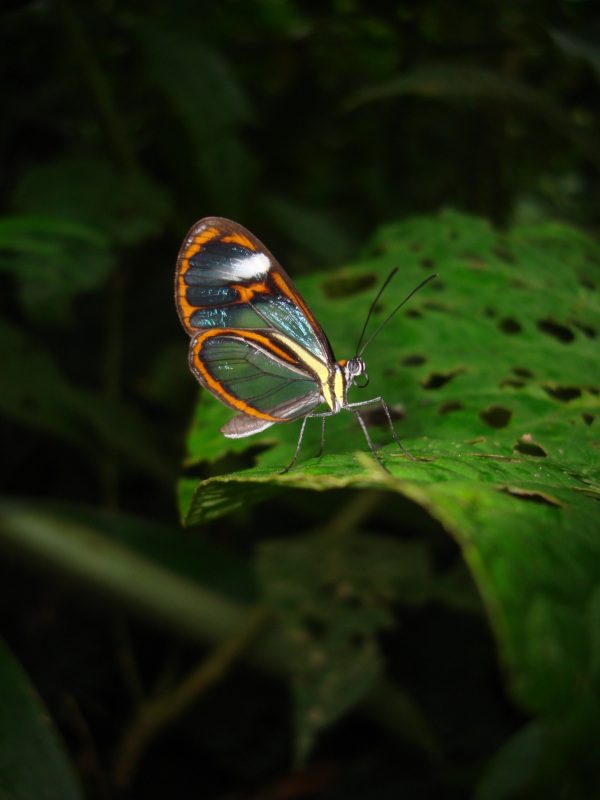When thinking of mimicry, most people picture two things that look identical, with little difference in pattern or color.
In nature, the mimicking of one bright warning color pattern among insects is common because it lets predators know to avoid them.
Florida Museum of Natural History researchers and colleagues, however, recently discovered multiple groups of butterflies in the same Amazonian rainforest are using different mimicry patterns to warn off predators.

Florida Museum of Natural History photo by Marianne Elias
These different groups are called mimicry rings and are made up of about five to 10 species of butterflies that look virtually identical, which tells insectivorous birds what to avoid. However, rather than just one mimicry ring occurring in any single place, butterflies with 10 or more different warning color patterns can be found flying together in the same rainforest.
Keith Willmott, an associate curator in the museum’s McGuire Center for Lepidoptera and Biodiversity, says there are many explanations for this phenomenon, but one of the most interesting is that these mimicry rings might live in different parts of the forest that have different species of birds.
“The theory is that two or more patterns might be optimal in the forest, depending on where those butterflies live and the birds that they tend to encounter,” Willmott said. “So a butterfly may fly in one area of the forest where birds are most familiar with its warning color pattern, whereas another pattern may provide better protection in a different part of the forest.”
The two most commonly found patterns at the study site were eurimedia — a brown and yellow color pattern — and the hermias — a black, orange and yellow color pattern — because they had the best defense against specific birds living in different areas of the forest.
“Having these two kinds of color patterns allows these butterflies to partition up the forest so they can make use of different resources and potentially avoid competition,” Willmott said.
He worked with three other researchers on a study published in the Royal Society Proceedings B journal to test this theory. The scientists studied 64 species of clearwing butterflies and their co-mimics.

Florida Museum of Natural History photo by Kim Garwood
He said previous studies have shown that mimicry rings can vary in different parts of the forest or at different heights above the ground, but this was the first study to compare the distribution of birds and butterflies simultaneously.
He said this study found that predation rates on a single pattern could vary significantly in different parts of the forest.
Willmott also said organisms other than butterflies show a diversity of warning color patterns, and this study could open new doors to research.
“I think mimicry is just a very easily studied example of different predator adaptations, and some kind of adaptation for defense occurs in all prey species,” he said. “In addition, the idea that diversification can also be driven by selection for different adaptations to predators is an important one.”
Going forward, Willmott said there are still many questions to be answered. He said these include how the distribution of caterpillar food plants is related to the distribution of adult butterflies and identifying which species of insectivorous birds are the most important predators.
“We also don’t really know anything about how butterfly species may differ in palatability to predators, and therefore whether some species are more important in driving the distribution of these mimicry rings than others,” he said. “These are the kinds of studies that would likely need several years of very intensive field study. There are still almost endless opportunities for research.”
Learn more about the McGuire Center for Lepidoptera & Biodiversity at the Florida Museum.
Learn more about the Butterfly Rainforest at the Florida Museum.